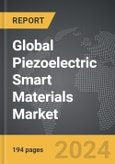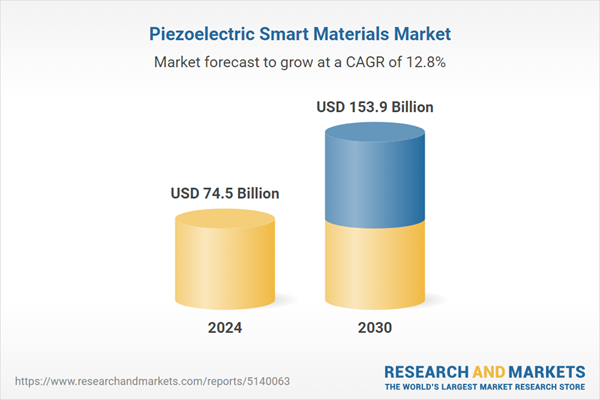Global Piezoelectric Smart Materials Market - Key Trends and Drivers Summarized
Revolutionizing Technology: The Emergence of Piezoelectric Smart Materials
Piezoelectric smart materials are advanced composites that can convert mechanical energy into electrical energy and vice versa, thanks to the piezoelectric effect. These materials, which include ceramics like lead zirconate titanate (PZT) and polymers such as polyvinylidene fluoride (PVDF), respond dynamically to environmental changes by generating an electric charge when subjected to mechanical stress or deforming when an electric field is applied. This dual functionality allows piezoelectric smart materials to be used both as sensors, detecting pressure, vibration, and strain, and as actuators, creating precise movements or deformations. The integration of these materials into various applications has enabled significant advancements in technology, providing real-time feedback and control mechanisms that enhance performance and efficiency in numerous fields.How Are Piezoelectric Smart Materials Applied in Modern Industries?
Piezoelectric smart materials are increasingly being utilized across a wide range of industries, revolutionizing traditional processes and applications. In the aerospace sector, these materials are used for vibration control and structural health monitoring, enhancing the safety and longevity of aircraft. The automotive industry employs piezoelectric sensors for precise airbag deployment, fuel injection systems, and tire pressure monitoring, improving vehicle safety and performance. In the medical field, piezoelectric materials are critical in the development of advanced diagnostic tools such as ultrasound imaging and wearable health monitors that provide continuous, real-time data. Additionally, the integration of piezoelectric smart materials in consumer electronics, including touch-sensitive screens and haptic feedback devices, enhances user interaction and experience. The construction industry benefits from these materials through smart infrastructure that can self-monitor for stress and potential failures, ensuring structural integrity and reducing maintenance costs. The versatility and adaptability of piezoelectric smart materials make them indispensable in modern industrial applications.What Are the Current Trends in Piezoelectric Smart Materials Technology?
The landscape of piezoelectric smart materials technology is evolving rapidly, with several key trends shaping its development and application. One major trend is the advancement in material science, leading to the discovery and synthesis of new piezoelectric materials with enhanced properties such as higher sensitivity, flexibility, and biocompatibility. This includes the development of lead-free piezoelectric materials that are environmentally friendly and safe for medical applications. Another significant trend is the miniaturization of piezoelectric components, enabling their integration into microelectromechanical systems (MEMS) and nanotechnology applications, which are crucial for creating compact, high-performance devices. The use of additive manufacturing and 3D printing techniques is also emerging, allowing for the customized production of complex piezoelectric structures tailored to specific applications. Additionally, there is growing interest in hybrid systems that combine piezoelectric materials with other smart materials, such as shape memory alloys and electroactive polymers, to achieve multifunctional capabilities. These trends highlight the continuous innovation in piezoelectric smart materials, expanding their potential and impact across various industries.What Factors Are Driving the Growth in the Piezoelectric Smart Materials Market?
The growth in the piezoelectric smart materials market is driven by several factors, reflecting the increasing demand for advanced materials that enhance performance and functionality in diverse applications. Technological advancements, particularly in material science and manufacturing processes, are enabling the production of more efficient and versatile piezoelectric materials, making them more accessible and appealing to various industries. The rising adoption of smart technologies and automation in sectors such as aerospace, automotive, healthcare, and consumer electronics is a significant driver, as these materials offer precise control and real-time feedback essential for modern applications. The push towards sustainability and environmentally friendly solutions is also propelling the market, with the development of lead-free piezoelectric materials addressing regulatory and safety concerns. Furthermore, the growing need for advanced diagnostic and monitoring tools in the medical and infrastructure sectors is driving demand for piezoelectric smart materials. These factors, combined with ongoing research and innovation, are fostering robust growth in the piezoelectric smart materials market, underscoring their critical role in the future of technology and industrial advancement.Report Scope
The report analyzes the Piezoelectric Smart Materials market, presented in terms of market value (USD). The analysis covers the key segments and geographic regions outlined below.- Segments: Type (Ceramics, Polymers, Composites, Crystals); Application (Sensors, Motors, Transducers, Other Applications); End-Use (Aerospace & Defense, Automotive, Building & Construction, Healthcare, Other End-Uses).
- Geographic Regions/Countries: World; United States; Canada; Japan; China; Europe (France; Germany; Italy; United Kingdom; and Rest of Europe); Asia-Pacific; Rest of World.
Key Insights:
- Market Growth: Understand the significant growth trajectory of the Ceramics segment, which is expected to reach US$68.4 Billion by 2030 with a CAGR of 13.1%. The Polymers segment is also set to grow at 15% CAGR over the analysis period.
- Regional Analysis: Gain insights into the U.S. market, valued at $20.4 Billion in 2024, and China, forecasted to grow at an impressive 11.8% CAGR to reach $23.2 Billion by 2030. Discover growth trends in other key regions, including Japan, Canada, Germany, and the Asia-Pacific.
Why You Should Buy This Report:
- Detailed Market Analysis: Access a thorough analysis of the Global Piezoelectric Smart Materials Market, covering all major geographic regions and market segments.
- Competitive Insights: Get an overview of the competitive landscape, including the market presence of major players across different geographies.
- Future Trends and Drivers: Understand the key trends and drivers shaping the future of the Global Piezoelectric Smart Materials Market.
- Actionable Insights: Benefit from actionable insights that can help you identify new revenue opportunities and make strategic business decisions.
Key Questions Answered:
- How is the Global Piezoelectric Smart Materials Market expected to evolve by 2030?
- What are the main drivers and restraints affecting the market?
- Which market segments will grow the most over the forecast period?
- How will market shares for different regions and segments change by 2030?
- Who are the leading players in the market, and what are their prospects?
Report Features:
- Comprehensive Market Data: Independent analysis of annual sales and market forecasts in US$ Million from 2024 to 2030.
- In-Depth Regional Analysis: Detailed insights into key markets, including the U.S., China, Japan, Canada, Europe, Asia-Pacific, Latin America, Middle East, and Africa.
- Company Profiles: Coverage of players such as AAC Technologies Holdings, Inc., APC International Ltd., Arkema Group, Cedrat Technologies, Kyocera Corporation and more.
- Complimentary Updates: Receive free report updates for one year to keep you informed of the latest market developments.
Some of the 42 companies featured in this Piezoelectric Smart Materials market report include:
- AAC Technologies Holdings, Inc.
- APC International Ltd.
- Arkema Group
- Cedrat Technologies
- Kyocera Corporation
- Mide Technology Corporation
- Piezo Kinetics, Inc.
- QorTek, Inc.
- Solvay SA
This edition integrates the latest global trade and economic shifts into comprehensive market analysis. Key updates include:
- Tariff and Trade Impact: Insights into global tariff negotiations across 180+ countries, with analysis of supply chain turbulence, sourcing disruptions, and geographic realignment. Special focus on 2025 as a pivotal year for trade tensions, including updated perspectives on the Trump-era tariffs.
- Adjusted Forecasts and Analytics: Revised global and regional market forecasts through 2030, incorporating tariff effects, economic uncertainty, and structural changes in globalization. Includes historical analysis from 2015 to 2023.
- Strategic Market Dynamics: Evaluation of revised market prospects, regional outlooks, and key economic indicators such as population and urbanization trends.
- Innovation & Technology Trends: Latest developments in product and process innovation, emerging technologies, and key industry drivers shaping the competitive landscape.
- Competitive Intelligence: Updated global market share estimates for 2025, competitive positioning of major players (Strong/Active/Niche/Trivial), and refined focus on leading global brands and core players.
- Expert Insight & Commentary: Strategic analysis from economists, trade experts, and domain specialists to contextualize market shifts and identify emerging opportunities.
Table of Contents
Companies Mentioned (Partial List)
A selection of companies mentioned in this report includes, but is not limited to:
- AAC Technologies Holdings, Inc.
- APC International Ltd.
- Arkema Group
- Cedrat Technologies
- Kyocera Corporation
- Mide Technology Corporation
- Piezo Kinetics, Inc.
- QorTek, Inc.
- Solvay SA
Table Information
| Report Attribute | Details |
|---|---|
| No. of Pages | 182 |
| Published | December 2025 |
| Forecast Period | 2024 - 2030 |
| Estimated Market Value ( USD | $ 74.5 Billion |
| Forecasted Market Value ( USD | $ 153.9 Billion |
| Compound Annual Growth Rate | 12.8% |
| Regions Covered | Global |









